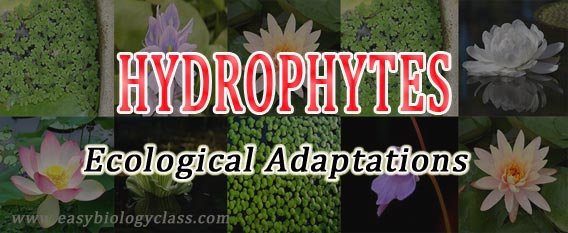What is adaptation?
“Any feature of an organism which enables it to exist under conditions of its habitat is called adaptation”. Adaptations are for withstanding adverse conditions of environment and to utilize the maximum benefit of the environment (nutrition or conditions). Adaptations in plants can be of four types:
1. Morphological features
2. Anatomical features
3. Physiological characters
4. Reproductive characters
Classification of plants based on water relation (Warming, 1990)
(1). Hydrophytes: plants growing in or near water.
(2). Xerophytes: plants adapted to survive under very poor availability of water.
(3). Mesophytes: plants growing in an environment which is neither very dry nor very wet.
What are hydrophytes?
Ø Hydrophytes (aquatic plants, water plants) are plants growing in or near water.
Ø These plants are adapted to survive in excess of water in their surroundings.
Ø Greek: Hudor = water; Phyton = plant: water plant
Ø Examples: Utricularia, Vallisneria, Hydrilla, Chara, Ceratophyllum, Trapa
Ø Aquatic plants are the producers of the aquatic ecosystem.
Ø They fix sunlight and ensures the survival of an aquatic ecosystem.
Ø Even though plants originated in water, except algae, most of the aquatic plants are evolved from their mesophytic relatives.
You may also like NOTES in...
BOTANY BIOCHEMISTRY MOL. BIOLOGY
ZOOLOGY MICROBIOLOGY BIOSTATISTICS
ECOLOGY IMMUNOLOGY BIOTECHNOLOGY
GENETICS EMBRYOLOGY PHYSIOLOGY
EVOLUTION BIOPHYSICS BIOINFORMATICS
Examples of hydrophytes:
Free floating plants: Lemna, Salivina, Azolla, Wolffia, Pistia
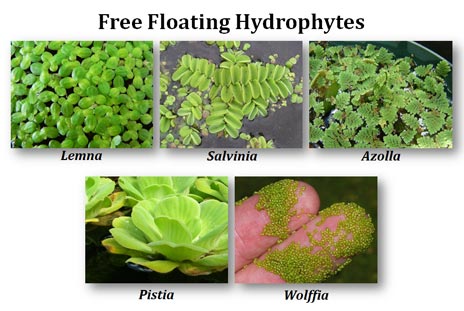
Submerged hydrophytes: Hydrilla, Utricularia, Vallisneria, Chara, Ceratophyllum
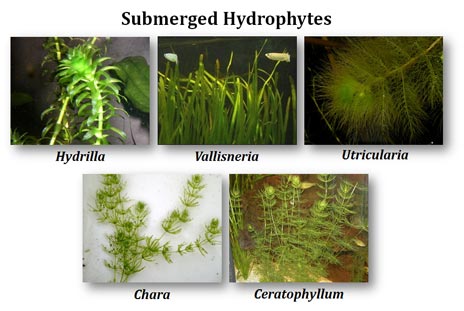
Pond plants example: water lily, Hydrilla, Utricularia, Vallisneria, Cabomba
Marshy plants: Oryza sativa, Marsilea, Sagittaria, Typha

Marine/salt water plants: algae like Sargassum, Ulva, Fucus, Polysiphonia; Sea grasses like Phyllospadix, Zostera, Halodule
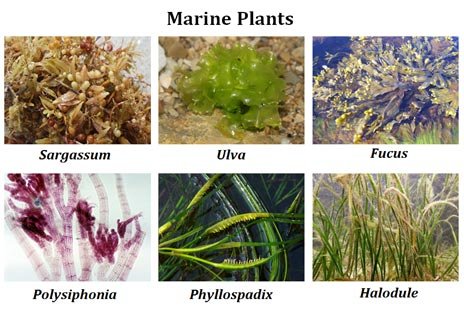
Halophytic plants (mangrove plants): Rhizophora, Avicennia, Kandelia candel, Carallia brachiata
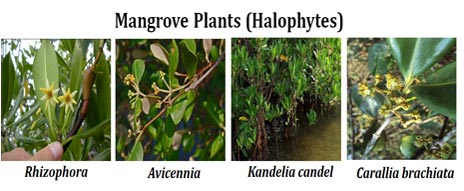
Factors affecting plants in the aquatic environment
Ø The growth of the plants in the water are affected by:
Ø Temperature of the water
Ø Osmotic concentration of the water
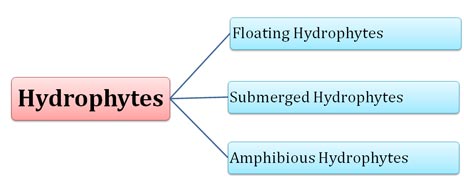 Ø Toxicity of the water
Ø Toxicity of the water
Ø Dissolved oxygen in the water
Ø Nutrients in the water
Ø Flow of water
Ø Turbidity of water
Classification of hydrophytes:
Ø Hydrophytes are classified into three groups based on relation to water and air.
1. Submerged hydrophytes
2. Floating hydrophytes
3. Amphibious hydrophytes
(1). Submerged hydrophytes:
Ø Plants growing below the water surface.
Ø They are NOT in direct contact with the air.
Ø They may be of two types
(1). Rooted submerged hydrophytes: Plants will be rooted in the soil (Vallisneria, Hydrilla, Potamogeton)
(2). Free floating submerged hydrophytes (Utricularia, Ceratophyllum)
(2). Floating hydrophytes:
Ø These plants float freely on the surface of the water.
Ø Here the plants will contact with both air and water.
Ø Two types:
Ø Free floating hydrophytes: not rooted in the soil: Wolffia microscopica
Ø Floating but rooted hydrophytes: rooted in the soil: Nymphaea, Nelumbium, Victoria regia
(3). Amphibious hydrophytes:
Ø These plants are adapted to both aquatic and terrestrial mode of life.
Ø They grow either in the shallow water or in the muddy soil.
Ø Examples: Oryza sativa, Marsilea, Sagittaria
Ø They are the important plant population in marshy areas.
Ø Marsh plants: shoot completely exposed to air but roots are completely buried in the soil (example: Cyperus, Typha)
Ecological Adaptations of hydrophytes:
Ø Hydrophytes shows three levels of Ecological Adaptations, they are:
(1). Morphological adaptations: (Adaptations in external features)
(2). Anatomical adaptations (Adaptations in internal features)
(3). Physiological adaptations (Adaptations in metabolic features)

(1). Morphological Adaptions of Hydrophytes:
(a). Roots in hydrophytes:
Ø Roots are poorly developed, reduced or absent in hydrophytes.
Ø Roots are not required for the absorption of water or nutrients.
Ø The entire plant surface can absorb water and minerals.
Ø Root caps usually absent.
Ø Root tips are often provided with root pockets or root sheath.
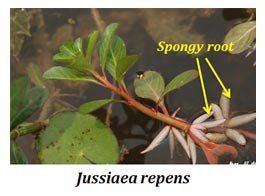 Ø In Jussiaea repens, two types of root are developed. The first one is normal roots and the second one is floating roots.
Ø In Jussiaea repens, two types of root are developed. The first one is normal roots and the second one is floating roots.
§ Floating roots are negatively geotropic and they are spongy in structure.
§ Spongy roots help the plant to float in the water.
(b). Stem in hydrophytes:
Ø The stem in hydrophyte is very delicate and usually green in colour.
Ø In most of the hydrophytes, the stem is modified into rhizome or runner.
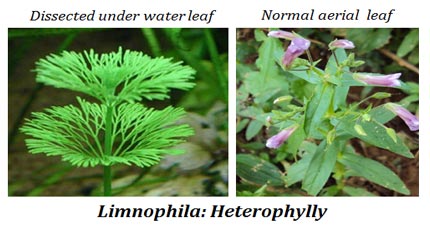 (c). Leaves in hydrophytes:
(c). Leaves in hydrophytes:
Ø In floating hydrophytes, the leaves are long, circular, green, thin and smooth.
Ø In these plants, the upper surface of the leaf is exposed to air whereas the lower surface touches the water.
Ø In Lotus, the petiole show indefinite growth and thus always keeps the leaves floating in the water.
Ø Heterophylly (morphologically different leaves in a single plant) is present in some plants.
Ø In heterophyllous forms, the submerged leaves are linear or ribbon like or highly dissected, whereas the floating leaves or aerial leaves are usual or circular shaped.
Ø The leaves of free floating hydrophytes are with smooth waxy surface.
Ø The wax coating protects the leaves from chemical and physical injuries.
Ø They also prevent water clogging of stomata during rainy seasons
Ø In Eichhornia, the leaves are with swollen and spongy petiole for providing buoyancy
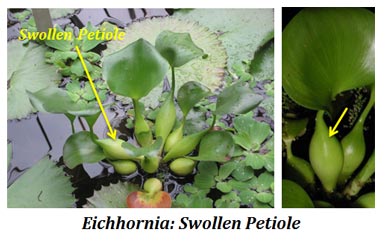 (2). Anatomical Adaptations of Hydrophytes
(2). Anatomical Adaptations of Hydrophytes
Ø Anatomically the hydrophytes shows the following characteristics and their anatomical adaptations ensure these features:
(A). Reduction in protecting structures
(B). Increase in the aeration
(C). Reduction of supporting or mechanical tissues
(D). Reduction in vascular tissues
(A). Reduction in protecting structures
Ø The cuticle is totally absent in submerged parts of hydrophytes.
Ø In aerial parts, the cuticle may present as a very thin layer.
Ø Epidermis is NOT the protecting layer.
Ø Epidermal cells contain chloroplasts.
Ø Epidermal cells can absorb water and nutrients.
Ø Hypodermis poorly developed, cells are thin walled.
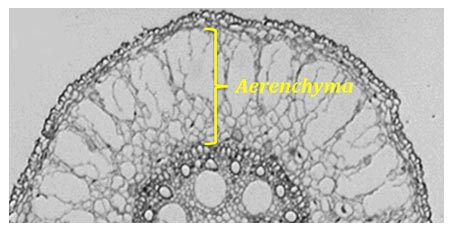 (B). Increase in the aeration
(B). Increase in the aeration
Ø Stomata is completely absent in submerged parts of hydrophytes.
Ø Sometimes vestigial stomata present.
Ø Exchange of gases in hydrophytes takes place through the cell wall.
Ø In floating plants stomata confined to upper epidermis of the leaf.
Ø The aerenchyma is well developed in submerged plants.
Ø Air chambers in the aerenchyma are filed with respiratory gases and moisture.
(C). Reduction of supporting or mechanical tissues
Ø Mechanical tissues are absent or poorly developed in hydrophytes.
Ø Thick walled sclerenchymatous cells totally absent in hydrophytes
Ø In Nymphaea, special type of star shaped lignified cells (asterosclereids) present which will provide mechanical support.
Ø Main function of roots is to anchor in the soil (NOT the absorption of nutrients and water).
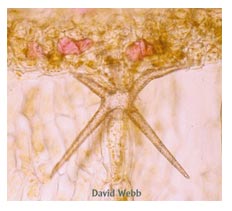
Asterosclereid in Nymphaea
(D). Reduction in the vascular tissues
Ø Vascular elements are poorly developed in hydrophytes.
Ø Absorption of water and minerals takes place through the cell surface.
Ø Thus very little importance is there for vascular tissues.
Ø The xylem is highly reduced in the vascular bundles of hydrophytes.
Ø Usually, the xylem is represented by few tracheids only.
Ø Sometimes the xylem not at all developed.
Ø Phloem usually ill developed, sometimes well developed.
Ø Vascular bundles are arranged towards the centre of the organ.
Ø Secondary growth totally absent.
(3). Physiological Adaptations of Hydrophytes
Ø Low osmotic concentration of cell sap in hydrophytes.
Ø The osmotic concentration is equal or slightly higher to that of surrounding water.
Ø This prevents the unnecessary entry of water into the cells.
Ø Water is absorbed by the entire plant surface.
Ø Nutrients are absorbed by entire plant surface.
Ø Gaseous exchange takes place through the entire plant surface.
Ø Both stem and leaves can do photosynthesis.
Ø Oxygen produced by photosynthesis is retained in the air cavities.
Ø This oxygen is utilized when required.
Ø Transpiration absent in submerged plants.
Ø Emerged plants and floating plants have excessive transpiration.
| You may also like... | ||
|---|---|---|
| NOTES | QUESTION BANK | COMPETITIVE EXAMS. |
| PPTs | UNIVERSITY EXAMS | DIFFERENCE BETWEEN.. |
| MCQs | PLUS ONE BIOLOGY | NEWS & JOBS |
| MOCK TESTS | PLUS TWO BIOLOGY | PRACTICAL |
Ø Mucilage cells produce plenty of mucilage.
Ø Mucilage prevents the decay of plants in the water.
Ø Vegetative reproduction is the most common method of reproduction
Ø Pollination and dispersal of fruits in hydrophytes are facilitated by water
Learning objectives:
Ø What is plant adaptation? What are the importance of plant adaptations?
Ø What are hydrophytes?
Ø What are the characteristics of aquatic plants?
Ø What are the ecological adaptations of hydrophytes?
Ø Examples of aquatic plants
Ø Free floating plants
Ø Under water plants
Ø Pond plants examples
Ø What are the morphological adaptations of hydrophytes?
Ø What are the anatomical adaptations of hydrophytes
Ø What are the physiological adaptations of hydrophytes?

